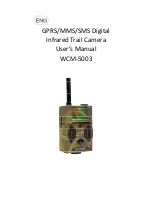
Handbook for the TRIUS PRO-694C Issue 1 September 2020
27
3) Withdraw the body cylinder and unscrew the two top spacer pillars from the PCB.
Now gently lift the PCB off the 20 way connector NOTING THE ORIENTATION OF THE
BOARD for correct replacement later. Now remove the lower two spacers from the
heat sink plate assembly.
4) The camera heat sink assembly can now be lifted away from the camera front
barrel and the CCD will be exposed. Note that a layer of white heat-sink compound is
applied to the periphery of the heat sink disc and this should be left undisturbed by
subsequent operations.
5) You can now closely examine the CCD faceplate under the spotlight using the
watchmaker's glass when any dust motes will show clearly. If there is only an odd
particle or two and the CCD is otherwise clean, carefully brush away the dust with a
corner of your lens cloth. A smeared or very dusty CCD will need a few drops of
alcohol to clean thoroughly and you may have to make several attempts before the
surface is free of contamination. One gentle wipe from one end to the other, with no
return stroke, will be found to be the most effective action. DO NOT rub vigorously
and be very careful to avoid scratching the window.
6) Before re-assembly, make certain that the inside surface of the front window is
also clean, and then carefully replace the camera front barrel and screw it into place.
(If the heat sink seal is disturbed, renew it with fresh compound before
reassembling).
7) Replace all the camera parts in reverse order and the job is done.
Dealing with condensation:
The
TRIUS-H694 is designed to avoid condensation by minimising the volume of gas
trapped within the CCD cavity and by preventing moisture ingress. This normally
works very well, but storage of the camera in a humid location can lead to the
trapped argon becoming moist by diffusion through the optical window mounting
thread etc. and can result in condensation on the CCD window. If this becomes a
problem, try storing the camera in a warm, dry place, or in a plastic lunch box
containing a sachet of silica gel desiccant. If this is not effective, it is possible to flush
the CCD chamber with dry argon from a small welding gas cylinder. Such argon gas
cylinders, valves and suitable plastic tubing, are readily available from many car
spares suppliers, such as Halfords, in the UK.Two ports are provided in the sides of
the CCD cavity and these may be accessed by unscrewing the rear plate of the
camera and then sliding off the main barrel.




































